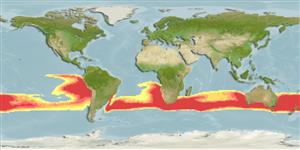Actinopterygii (ray-finned fishes) >
Perciformes (Perch-likes) >
Centrolophidae (Medusafishes)
Etymology: Schedophilus: Name from Greek words 'phylos' (?????), t) meaning 'one who likes' and "s 'shedia' (??????) which means raft; literally means 'the one who likes rafts'. This probably refers to the lifestyle ot the juveniles of this genus (Michail Ragousis, mar10091@marine.aegean.gr, pers. Comm. 01/16) which are epipelagic and associate with floating jellyfish..
Environment / Climate / Range
Ecology
Marine; bathypelagic; depth range 40 - 500 m (Ref. 27121). Deep-water, preferred ?; 2°N - 45°S, 180°W - 180°E
Eastern Atlantic: Gulf of Guinea (Ref. 2683), St. Helena, Vema Seamount, Tristan da Cunha and South Africa. Western Indian Ocean: St. Paul and Amsterdam islands. Southwest Pacific: Australia (including Lord Howe Island), New Zealand (Ref. 5755) and Rapa Island. Southeast Pacific: Easter Island, Juan Fernandez Islands.
Size / Weight / Age
Maturity: Lm ? range ? - ? cm
Max length : 100.0 cm TL male/unsexed; (Ref. 27121)
Found near islands (Ref. 27000). Feeds on planktonic salps, cephalopods and small fishes (Ref. 11228). Minimum depth reported from Ref. 11228.
Life cycle and mating behavior
Maturity | Reproduction | Spawning | Eggs | Fecundity | Larvae
Heemstra, P.C., 1995. Additions and corrections for the 1995 impression. p. v-xv. In M.M. Smith and P.C. Heemstra (eds.) Revised Edition of Smiths' Sea Fishes. Springer-Verlag, Berlin. (Ref. 11228)
IUCN Red List Status (Ref. 115185)
CITES (Ref. 94142)
Not Evaluated
Threat to humans
Harmless
Human uses
More information
Common namesSynonymsMetabolismPredatorsEcotoxicologyReproductionMaturitySpawningFecundityEggsEgg development
ReferencesAquacultureAquaculture profileStrainsGeneticsAllele frequenciesHeritabilityDiseasesProcessingMass conversion
Tools
Special reports
Download XML
Internet sources
